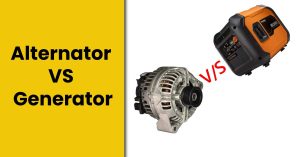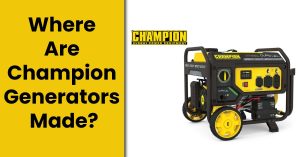How To Ground A Generator Safely? – [Pro Tips]
You must be aware of the importance of generators in your routine life. While keeping their usage in mind you may have purchased one. If you are not an electrician, then you must be confused about whether you should ground your generator or not.
Though grounding a generator isn’t an easy task there are several factors involved in influencing your decision to do so. And in fact, grounding sometimes doesn’t even matter.
In this article, we will elaborate on the whole process of grounding a generator. The answers to your questions such as, whether should you ground your generator or how to ground a generator will also be explained.
What Is Grounding?
To generate electricity temporarily in remote areas, in times of crisis, smaller portable generators are used at a smaller scale as compared to those used in utility companies. The proper wiring to be used for electricity backup situations depends on the way of using a generator.
The area or home whatever you want to power up will be completely safe from any short circuit or other issues that usually arise from lack of grinding.
Basically, grounding is the connection of an electrical circuit to a reference ground. Such as the frame of the generator will act as the electrical circuit while the ground rod will act as the reference ground.
To simplify things for better understanding, just picture the connection between the frame of the generator and the neutral wire. Make sure that the connection is fully grounded.
Do You Need To Ground Your Portable Generator?

Almost all portable generators need to be grounded for safety measures. But is there anything special you need to do in order to ground your generator? Well, it depends on the design of the generator.
Most of the advanced models of generators are designed in such as way that the metal frame around them acts as a path of minimum electrical resistance. The engine, fuel tank, as well as generator are together bonded to the frame. If any electricity flows through the outside wiring of the generator, will be grounded by the frame.
The best and easy way to find out the need for grounding is to check the manual guide by the owner. The manufacturer of the generator should provide clear instructions on whether it needs to be grounded or not.
If it is not clearly mentioned in the manual, then you can also inspect the construction of your generator. If the transfer switch of the generator delivers the option to transfer current to a neutral ground conductor, the components of your generator may consist of a separately derived system. It means, there will be a need for connecting the generator to a separate grounding rod.
Checkout the list of best portable Rv generators
Tools Needed To Ground A Portable Generator
The following equipment will be needed when you will try to ground a generator:
Wire Strippers
A pair of sharp wire strippers will be needed. If the wire strippers are a bit worn out then you can sharpen them with ease by using honing steel. It is not recommended to use a blunt wire stripper as it may lead to damage or cut wires improperly which will lead to electrical malfunctions.
Pliers:
A good pair of pliers is essential for twisting and turning the wires around the generator as well as the grounding rod. Using a nice pair of long nose pliers is highly recommended for easier twisting.
Wrench:
A wrench will help to loosen and tighten the bolts in the generator. The type of wrench used will depend on the size of bolts in the generator. If you are unaware of the size of the bolts, you can use an adjustable wrench for bolts adjustment.
These are the tools required to strip the copper grounding wire and to connect it to the grounding rod as well as the grounding bolt of the generator.
Copper Grounding Rod:
The design of a copper grounding rod is basically to drive it inside the ground to safely dissipate the electric current. Most of the generators require a copper rod of four feet in length. However, a longer rod can also be used for in-depth grounding.
Copper Grounding Wire:
This is used to connect the grounding bolt on your generator to the grounding rod. The amount of wire needed for this purpose will depend on the distance between the buried rod and the generator. You should have some extra wires that will be helpful in driving the rod into the ground easily.
Mallet or Hammer:
A heavy and blunt object will be required to drive copper grounding wire inside the ground. A shovel or spike can also be useful depending on the terrain.
Shovel:
A heavy-duty shovel will make it easier to place a copper grounding rod about 8 to 10 feet below the ground. By the usage of the shovel, you can easily avoid getting a copper grounding rod scratched. In rocky terrain, a shovel can be very handy.
Checkout our guide about How to Use A Generator During A Power Outage
Safety Precautions And Checklist
Before starting the grounding process, here are some safety precautions you can adopt in order to avoid getting any shock or electrocution:
Carefully inspect the generator and other equipment before usage and also remove the defective parts if they need any servicing for saving yourself from any damage.
If there is an open-transition transfer switch already installed in your generator then it is good, otherwise never attach your generator directly to any electrical system of your office or home.
Make sure to always maintain and operate the generator by the use and safety instructions recommended by the manufacturer.
A ground-fault circuit interrupter is also good if it is provided by the manufacturer’s instructions.
Do not connect your generator to any structure that is not properly installed transfer switch.
Ensure the proper bonding of non-current-carrying materials of the generator to the frame of the generator to prevent electrocutions as well as shocks.
Prefer to use cords supplied by the manufacturer while connecting electrical appliances or tools directly to the generator.
It is highly recommended to use heavy-duty cords containing a ground conductor, for example, a 3-wire flexible cord and 3-pronger cord connectors.
Check out our guide about how to parallel generators
How To Ground A Generator
After gathering all the gadgets and equipment on the spot, you can start the process of grounding now. The steps to ground a generator are mentioned below:
#1. Install The Copper Grounding Rod:
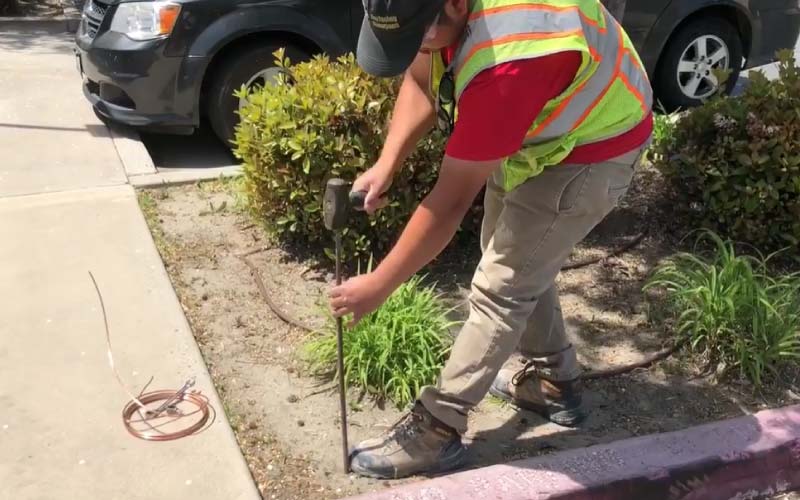
With the help of a hammer, sink the copper ground rod 8 feet into the ground. Sinking the rod deeper will ensure better earthing. Sometimes due to the hardness of the surface, it becomes difficult to sink the grounding rod in a smooth way.
To avoid this, you can pour some water and wait until the ground turns from hard to soft. In case, pouring water doesn’t help then you can sink the rod at a special angle. The recommended angle shouldn’t exceed 45°.
#2. Strip And Connect Copper Wire To Copper Rod:
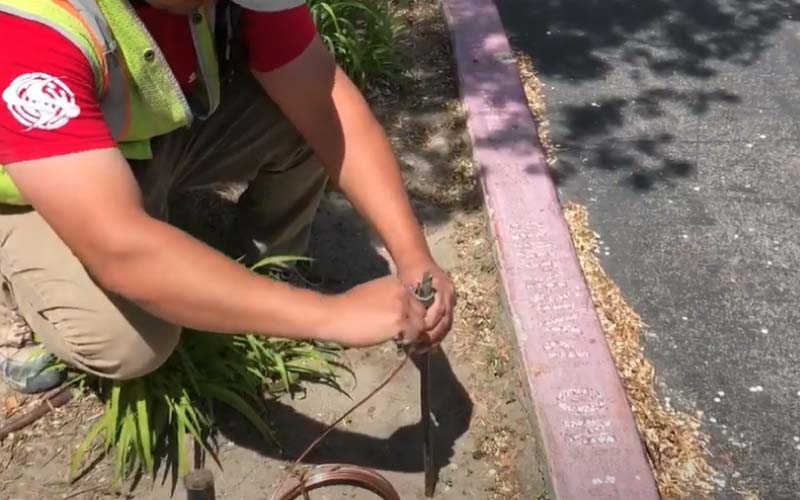
With the help of a wire stripper, strip both ends of copper wire prior to moving forward on the next step. You should be careful when doing this step as over-stripping the wire will leave most part of it bare or unattended.
#3. Wrap Copper Wire Around The Rod:
After sinking the rod at 8 feet inside the ground, now is the time to wrap one end of the copper wire tightly around the rod by using pliers. When done tightening the nut, try to ensure that the wire remains firmly in its place.
#4. Ground The Generator:
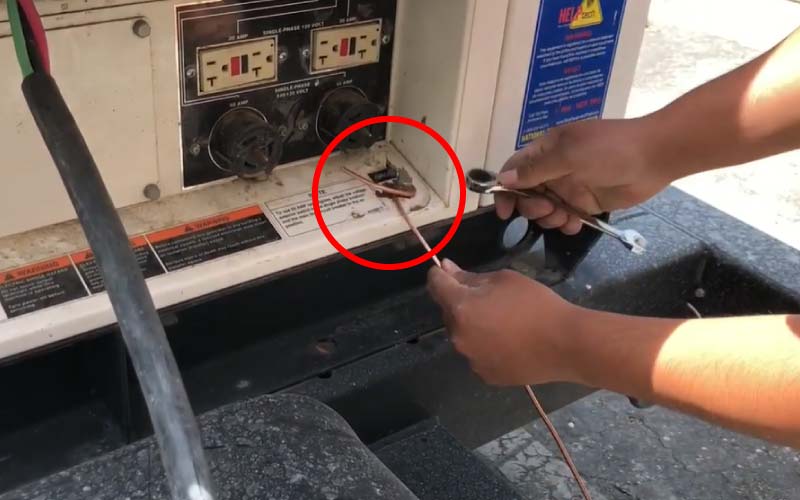
There is a bolt present on the generator for grounding purposes. Make it a bit loose with the help of a wrench and wrap the wire around it. Then tighten it up again. You can also use the option for bonding it in place as well.
What Happens If You Don’t Ground A Generator?
Potentially, very bad things can happen.
The process of grounding may take a bit of muscle in the long run but it is a simple thing to do that can save you from lots of pain- physically as well as financially.
There is a high risk of electrocution. It can also create a risk of damaging electrical equipment. It is just like frying yourself. While the cost it will cause, needs a lot more replacement and the things in its vicinity will also get burned.
Whenever you turn on and off the appliances, you will experience voltage spikes and surges. While a generator that hasn’t been grounded will offer no protection from spikes whether they occur naturally or not. Not only this but the wiring could get overheated as long as appliances are connected to them. There is also a chance of catching fire.
A generator will catches fire in this situation. So, if you know everything about the grounding like the benefits and harms, and if you still do not go for it, then bad things can happen easily.

Josh is a highly skilled electrician with specialized expertise in the field of generators. With years of experience under his belt, he has established himself as an expert in all aspects of generators, ranging from installation and maintenance to troubleshooting and repairs. Josh’s in-depth knowledge of electrical systems and his commitment to staying updated with the latest industry advancements make him a reliable and sought-after professional.



